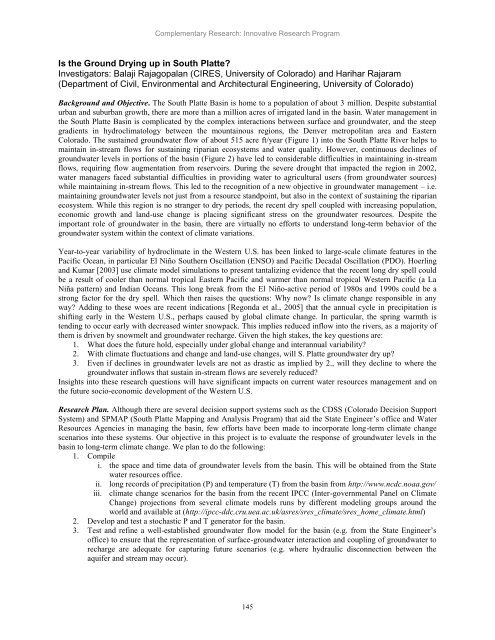Scientific Theme: Advanced Modeling and Observing Systems
Scientific Theme: Advanced Modeling and Observing Systems
Scientific Theme: Advanced Modeling and Observing Systems
Create successful ePaper yourself
Turn your PDF publications into a flip-book with our unique Google optimized e-Paper software.
Complementary Research: Innovative Research Program<br />
Is the Ground Drying up in South Platte?<br />
Investigators: Balaji Rajagopalan (CIRES, University of Colorado) <strong>and</strong> Harihar Rajaram<br />
(Department of Civil, Environmental <strong>and</strong> Architectural Engineering, University of Colorado)<br />
Background <strong>and</strong> Objective. The South Platte Basin is home to a population of about 3 million. Despite substantial<br />
urban <strong>and</strong> suburban growth, there are more than a million acres of irrigated l<strong>and</strong> in the basin. Water management in<br />
the South Platte Basin is complicated by the complex interactions between surface <strong>and</strong> groundwater, <strong>and</strong> the steep<br />
gradients in hydroclimatology between the mountainous regions, the Denver metropolitan area <strong>and</strong> Eastern<br />
Colorado. The sustained groundwater flow of about 515 acre ft/year (Figure 1) into the South Platte River helps to<br />
maintain in-stream flows for sustaining riparian ecosystems <strong>and</strong> water quality. However, continuous declines of<br />
groundwater levels in portions of the basin (Figure 2) have led to considerable difficulties in maintaining in-stream<br />
flows, requiring flow augmentation from reservoirs. During the severe drought that impacted the region in 2002,<br />
water managers faced substantial difficulties in providing water to agricultural users (from groundwater sources)<br />
while maintaining in-stream flows. This led to the recognition of a new objective in groundwater management – i.e.<br />
maintaining groundwater levels not just from a resource st<strong>and</strong>point, but also in the context of sustaining the riparian<br />
ecosystem. While this region is no stranger to dry periods, the recent dry spell coupled with increasing population,<br />
economic growth <strong>and</strong> l<strong>and</strong>-use change is placing significant stress on the groundwater resources. Despite the<br />
important role of groundwater in the basin, there are virtually no efforts to underst<strong>and</strong> long-term behavior of the<br />
groundwater system within the context of climate variations.<br />
Year-to-year variability of hydroclimate in the Western U.S. has been linked to large-scale climate features in the<br />
Pacific Ocean, in particular El Niño Southern Oscillation (ENSO) <strong>and</strong> Pacific Decadal Oscillation (PDO). Hoerling<br />
<strong>and</strong> Kumar [2003] use climate model simulations to present tantalizing evidence that the recent long dry spell could<br />
be a result of cooler than normal tropical Eastern Pacific <strong>and</strong> warmer than normal tropical Western Pacific (a La<br />
Niña pattern) <strong>and</strong> Indian Oceans. This long break from the El Niño-active period of 1980s <strong>and</strong> 1990s could be a<br />
strong factor for the dry spell. Which then raises the questions: Why now? Is climate change responsible in any<br />
way? Adding to these woes are recent indications [Regonda et al., 2005] that the annual cycle in precipitation is<br />
shifting early in the Western U.S., perhaps caused by global climate change. In particular, the spring warmth is<br />
tending to occur early with decreased winter snowpack. This implies reduced inflow into the rivers, as a majority of<br />
them is driven by snowmelt <strong>and</strong> groundwater recharge. Given the high stakes, the key questions are:<br />
1. What does the future hold, especially under global change <strong>and</strong> interannual variability?<br />
2. With climate fluctuations <strong>and</strong> change <strong>and</strong> l<strong>and</strong>-use changes, will S. Platte groundwater dry up?<br />
3. Even if declines in groundwater levels are not as drastic as implied by 2., will they decline to where the<br />
groundwater inflows that sustain in-stream flows are severely reduced?<br />
Insights into these research questions will have significant impacts on current water resources management <strong>and</strong> on<br />
the future socio-economic development of the Western U.S.<br />
Research Plan. Although there are several decision support systems such as the CDSS (Colorado Decision Support<br />
System) <strong>and</strong> SPMAP (South Platte Mapping <strong>and</strong> Analysis Program) that aid the State Engineer‘s office <strong>and</strong> Water<br />
Resources Agencies in managing the basin, few efforts have been made to incorporate long-term climate change<br />
scenarios into these systems. Our objective in this project is to evaluate the response of groundwater levels in the<br />
basin to long-term climate change. We plan to do the following:<br />
1. Compile<br />
i. the space <strong>and</strong> time data of groundwater levels from the basin. This will be obtained from the State<br />
water resources office.<br />
ii. long records of precipitation (P) <strong>and</strong> temperature (T) from the basin from http://www.ncdc.noaa.gov/<br />
iii. climate change scenarios for the basin from the recent IPCC (Inter-governmental Panel on Climate<br />
Change) projections from several climate models runs by different modeling groups around the<br />
world <strong>and</strong> available at (http://ipcc-ddc.cru.uea.ac.uk/asres/sres_climate/sres_home_climate.html)<br />
2. Develop <strong>and</strong> test a stochastic P <strong>and</strong> T generator for the basin.<br />
3. Test <strong>and</strong> refine a well-established groundwater flow model for the basin (e.g. from the State Engineer‘s<br />
office) to ensure that the representation of surface-groundwater interaction <strong>and</strong> coupling of groundwater to<br />
recharge are adequate for capturing future scenarios (e.g. where hydraulic disconnection between the<br />
aquifer <strong>and</strong> stream may occur).<br />
145
















